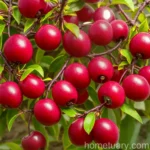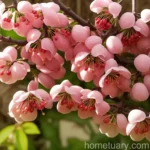Taiwan Cherry (Prunus ‘Okame’): A Detailed Plant Guide
Welcome to our comprehensive guide on the Taiwan cherry, scientifically known as Prunus ‘Okame’. This beautiful flowering tree is a popular choice among gardeners and landscape enthusiasts due to its stunning blossoms and ease of care. Throughout this article, we will delve into the cultural aspects, uses, maintenance, and interesting facts about the Taiwan cherry. Whether you are a seasoned gardener or a beginner looking to enhance your green space, this guide will provide you with valuable insights and tips regarding the cultivation and care of Prunus ‘Okame’.
What is Prunus ‘Okame’?
Prunus ‘Okame’ is a deciduous flowering tree that belongs to the Rosaceae family. It is a cultivar known for its abundant pink blooms that emerge in early spring, often before the foliage appears. This ornamental tree is a hybrid of two cherry species, Prunus incisa and Prunus campanulata. The hybridization has resulted in a tree that displays an exceptional floral display, making it a sought-after addition to gardens, parks, and urban landscapes.
The Taiwan cherry is known for its compact size and rounded shape, making it an excellent choice for small to medium-sized gardens. It typically reaches a height of 20 to 25 feet with an equally spread canopy, creating a visually appealing and balanced silhouette. The foliage of Prunus ‘Okame’ is also noteworthy, transitioning through vibrant shades of red and bronze in the fall before shedding its leaves for the winter.
Key Takeaways – Taiwan Cherry (Prunus ‘Okame’)
Before we delve into the specific aspects of cultivating and caring for Prunus ‘Okame’, let’s explore some key takeaways about this popular flowering tree:
- Prunus ‘Okame’ is a hybrid cultivar known for its abundant pink blossoms that appear in early spring.
- It is a compact deciduous tree, reaching a height of 20 to 25 feet, making it suitable for smaller gardens and urban landscapes.
- The foliage of the Taiwan cherry undergoes a beautiful color transformation in the fall, adding seasonal interest to the landscape.
- Due to its ornamental value and ease of care, Prunus ‘Okame’ is widely used in gardens, parks, and urban greening initiatives.
- The tree is appreciated for its ability to attract pollinators, adding biodiversity to outdoor spaces.
Now that we have gained a general understanding of Prunus ‘Okame’, let’s delve into the specific cultural aspects that are essential for its successful growth and development.
Culture
Cultural practices play a significant role in the overall health and vigor of Taiwan cherry trees. Proper cultural management ensures that the tree thrives, produces abundant blossoms, and remains resilient against environmental stressors. Let’s explore the cultural aspects of caring for Prunus ‘Okame’, including its water, sunlight, fertilizer, soil, and pruning requirements.
Water
- Watering Frequency: During the establishment phase, which typically spans the first two years after planting, regular watering is crucial. Ensure that the soil remains consistently moist but not waterlogged.
- Seasonal Variations: In the hotter months, especially during the flowering period, increased watering may be necessary to support the tree’s hydration needs. Conversely, reduce watering during the dormant winter months to prevent waterlogging and root rot.
Sunlight
- Sun Exposure Needs: Taiwan cherry trees thrive in full sun to partial shade. Ideally, they should receive at least 6 to 8 hours of direct sunlight daily to promote healthy growth and prolific flowering.
- Shade Tolerance: While the tree prefers ample sunlight, it can tolerate partial shade, making it suitable for locations with varying light conditions throughout the day.
Fertilizer
- Balanced Fertilization: Use a balanced, slow-release fertilizer in early spring to provide essential nutrients for the upcoming growing season. Avoid over-fertilization, as this can lead to excessive vegetative growth at the expense of flowering.
Soil
- Well-Draining Soil: Plant Prunus ‘Okame’ in well-draining soil with a slightly acidic to neutral pH. Amending heavy clay soil with organic matter can improve drainage and overall soil structure, promoting healthy root development.
Pruning
- Pruning Frequency: Regular pruning is not always necessary for Taiwan cherry trees, as they naturally form an attractive shape. However, selective pruning to remove dead, damaged, or crossing branches can enhance the tree’s appearance and overall health.
- Pruning Timing: The best time to prune Prunus ‘Okame’ is right after the flowering period, allowing ample time for new growth to develop and mature before the onset of winter.
Cultural management forms the foundation for the successful cultivation of Taiwan cherry trees. By addressing the tree’s water, sunlight, fertilizer, soil, and pruning needs, you can ensure that your Prunus ‘Okame’ thrives and flourishes in your garden or landscape.
Uses
Taiwan cherry (Prunus ‘Okame’) is valued for its diverse uses, ranging from ornamental landscaping to ecological benefits. Let’s explore the various applications of this versatile flowering tree.
Landscape Ornament
- Gardens and Parks: Prunus ‘Okame’ is commonly used as a focal point in gardens and public parks, where its early spring blossoms captivate visitors and herald the arrival of the new season.
- Urban Landscaping: Its compact size and attractive floral display make it well-suited for urban landscaping initiatives, where space may be limited, but the desire for greenery and beauty is high.
Ecological Value
- Pollinator Attraction: The nectar-rich blossoms of Taiwan cherry trees attract and nourish pollinators, including bees and butterflies, contributing to the ecological diversity of outdoor spaces.
- Wildlife Habitat: As the tree matures, it provides shelter and nesting sites for birds, further enhancing the biodiversity of the surrounding environment.
Seasonal Interest
- Spring Blossoms: The profusion of pink blossoms marks the end of winter and the onset of spring, adding a vibrant burst of color to the landscape.
- Fall Foliage: The stunning color transformation of the foliage in autumn provides visual interest and complements the seasonal palette of the surroundings.
Taiwan cherry trees offer a multitude of uses, whether as ornamental focal points in gardens, contributors to ecological diversity, or providers of seasonal interest throughout the year.
Propagation
Propagating Taiwan cherry (Prunus ‘Okame’) allows for the expansion of its presence in gardens and landscapes. There are several methods of propagation, including seed propagation, cutting propagation, and grafting. Let’s explore the propagation techniques suitable for Prunus ‘Okame’.
Seed Propagation
- Seed Collection: Collect ripe cherry seeds from mature fruits in the late summer or early autumn. Clean and dry the seeds before storage to prevent mold or fungal growth.
- Cold Stratification: To break dormancy and promote germination, cold stratify the seeds by storing them in moist paper towels within a plastic bag in the refrigerator for 90 to 120 days.
- Sowing: Plant the stratified seeds in pots or seed trays filled with well-draining potting mix in early spring. Keep the soil consistently moist and provide adequate sunlight for seedling growth.
Cutting Propagation
- Softwood Cuttings: Take 6 to 8-inch softwood cuttings in early summer, ensuring that they include a terminal bud and several pairs of leaves.
- Rooting Hormone: Dip the cut ends of the softwood cuttings in a rooting hormone to encourage root development and place them in a well-draining rooting medium, such as a mix of perlite and peat.
- Warm and Humid Environment: Provide bottom heat and maintain high humidity around the cuttings to facilitate the formation of roots. Once rooted, transplant the cuttings into individual pots.
Grafting
- Scion Selection: Choose healthy and disease-free scion wood from a mature Taiwan cherry tree during the dormant season.
- Rootstock Compatibility: Graft the scion onto a suitable rootstock, such as Prunus avium or Prunus serrulata, using a compatible grafting technique, such as whip grafting or cleft grafting.
- Graft Union Protection: Seal the graft union with grafting wax or tape to prevent desiccation and infection, providing an optimal environment for successful graft union formation.
Propagation allows for the multiplication of Prunus ‘Okame’ to expand its presence in landscapes and share its beauty with a wider audience. Whether through seed propagation, cutting propagation, or grafting, the propagation of Taiwan cherry trees contributes to the diversity of flowering trees in gardens and urban environments.
Container Popularity
The compact size and ornamental value of Taiwan cherry (Prunus ‘Okame’) make it well-suited for container cultivation. Growing Prunus ‘Okame’ in containers offers several advantages, including versatility, mobility, and the opportunity to enjoy its blossoms in various outdoor settings. Here are some key considerations when growing Taiwan cherry trees in containers:
- Container Selection: Choose a large, sturdy container with adequate drainage holes to accommodate the tree’s root system and promote healthy root growth.
- Well-Draining Potting Mix: Use a high-quality, well-draining potting mix to ensure proper aeration and moisture retention for the tree’s roots.
- Site Selection: Position the container in a location that receives ample sunlight, as Taiwan cherry trees require full sun to partial shade for optimal growth and flowering.
Cultivating Prunus ‘Okame’ in containers allows individuals with limited garden space or those residing in urban settings to enjoy the beauty of this flowering tree on patios, balconies, and courtyards. Container cultivation also provides greater flexibility in repositioning the tree to maximize its visual impact and exposure to sunlight.
Common Diseases
While Taiwan cherry (Prunus ‘Okame’) is relatively resistant to many diseases, it is essential to be aware of potential issues that may affect the tree’s health. By recognizing common diseases and promptly implementing appropriate measures, you can safeguard the vigor and longevity of your Taiwan cherry tree. Let’s explore some common diseases that may impact Prunus ‘Okame’.
Blossom Blight
- Causal Agent: Blossom blight is often caused by fungal pathogens, such as Monilinia fructicola or Monilinia laxa, which infect the tree during the flowering period.
- Symptoms: Infected blossoms may develop brown lesions, withering, and premature dropping. The disease can spread to twigs and shoots, leading to dieback if left unchecked.
- Preventive Measures: Prune and remove infected plant parts to prevent the spread of the disease. Where practical, provide adequate air circulation around the tree to reduce humidity and minimize favorable conditions for fungal growth.
Leaf Spot
- Causal Agent: Various fungal pathogens, including Diplocarpon mespili and Coccomyces hiemalis, can cause leaf spot on Taiwan cherry trees.
- Symptoms: Circular or irregular spots may appear on the leaves, exhibiting colors ranging from brown to purple. Severe infections can lead to premature leaf drop and reduced overall vigor.
- Cultural Practices: Maintain good sanitation by promptly removing and disposing of infected leaves. Avoid overhead watering to minimize leaf wetness, which creates favorable conditions for fungal proliferation.
Powdery Mildew
- Causal Agent: Powdery mildew is caused by fungal pathogens of the Erysiphales order, which form characteristic white powdery growth on leaf surfaces.
- Symptoms: Affected leaves develop a powdery white coating, with potential distortion and stunted growth. In severe cases, powdery mildew can impact the tree’s overall health and vigor.
- Cultural Control: Prune and thin the canopy to improve air circulation and reduce leaf humidity. Additionally, avoid overhead irrigation to minimize moisture on leaf surfaces.
Root Rot
- Causal Agent: Root rot is often incited by soil-borne fungal pathogens, such as Phytophthora spp., that thrive in waterlogged or poorly drained soil.
- Symptoms: Yellowing or wilting of foliage, stunted growth, and a general decline in the tree’s health may indicate root rot. The roots may appear discolored and mushy upon inspection.
- Preventive Measures: Ensure proper soil drainage and avoid overwatering to prevent the onset of root rot. Selecting well-draining planting sites and using raised beds can also mitigate the risk of the disease.
Disease Diagnosis
Diagnosing diseases that affect Taiwan cherry trees involves careful observation of symptoms, knowledge of prevalent pathogens, and an understanding of the tree’s cultural and environmental history. A systematic approach to disease diagnosis includes the following steps:
- Symptom Identification: Examine the tree for any abnormalities, including lesions on leaves, blossoms, or twigs, as well as changes in foliage color or texture.
- Environmental Assessment: Consider the prevailing weather conditions, including temperature, humidity, and rainfall, as these factors can influence disease development and progression.
- Cultural Review: Evaluate the tree’s cultural practices, such as watering, fertilization, and pruning, to identify any potential stressors or imbalances that may predispose the tree to disease.
- Pathogen Analysis: Familiarize yourself with common pathogens affecting Prunus ‘Okame’, including fungal, bacterial, and viral agents, to narrow down potential disease culprits.
- Consultation: If unsure about the diagnosis, consult with local horticultural extension services, plant pathologists, or certified arborists to seek professional advice and laboratory testing if necessary.
By diligently assessing the tree’s symptoms, environmental conditions, cultural practices, and potential pathogens, you can accurately diagnose diseases affecting Taiwan cherry trees and implement targeted management strategies to mitigate their impact.
Common Pests
Though relatively resistant to many pests, Taiwan cherry (Prunus ‘Okame’) may occasionally face challenges from insect pests that can affect its health and aesthetic appeal. Identifying common pests and implementing appropriate control measures is essential to safeguard the tree’s well-being. Let’s explore some common pests that may impact Taiwan cherry trees.
Aphids
- Identification: Aphids are small, soft-bodied insects that may appear in clusters on the underside of leaves or near new shoot growth. They come in various colors, including green, black, and red.
- Damage: Aphids feed by piercing the plant tissues and extracting sap, leading to distorted growth, yellowing leaves, and the secretion of sticky honeydew, which can attract sooty mold. Severe infestations can impact the tree’s overall vigor.
- Control: Control aphids through natural enemies, such as lady beetles and lacewings, or through the application of horticultural oils or insecticidal soaps if necessary.
Scale Insects
- Identification: Scale insects are small, often immobile pests that can be found attached to the stems, twigs, or leaves of the tree. They may appear as raised, waxy bumps or flat, disc-like coverings, depending on the species.
- Damage: Scale insects feed by piercing the plant tissues and withdrawing sap, leading to weakening, yellowing, and premature shedding of leaves. Heavy infestations can weaken the tree and make it susceptible to other stressors.
- Management: Encourage natural predators, such as parasitic wasps, to control scale insect populations. Prune and dispose of heavily infested plant parts, and consider targeted applications of horticultural oils to smother the pests.
Caterpillars
- Identification: Caterpillars, the larval stage of butterflies and moths, may feed on the foliage of Taiwan cherry trees, leaving behind ragged edges or holes in the leaves.
- Damage: While minor feeding by caterpillars may not significantly impact the tree, severe infestations can defoliate the tree and compromise its ability to photosynthesize, leading to reduced vigor.
- Control: Handpick and remove caterpillars when feasible, and encourage natural predators, such as birds and beneficial insects, to manage caterpillar populations. Bacillus thuringiensis-based biopesticides can be used for targeted control if necessary.
Leafhoppers
- Identification: Leafhoppers are small, wedge-shaped insects that may move quickly when disturbed. They feed by piercing plant tissues and extracting sap, often leading to a stippled or speckled appearance on the leaves.
- Damage: Leafhopper feeding can cause yellowing, stippling, and leaf curling, impacting the tree’s overall aesthetic value and photosynthetic capacity.
- Management: Introduce natural enemies, such as assassin bugs and predatory wasps, to control leafhopper populations. Consider the targeted application of insecticidal soaps or neem oil to manage significant infestations.
By identifying and understanding common pests that may affect Taiwan cherry trees, you can implement proactive management strategies to mitigate their impact and maintain the health and beauty of Prunus ‘Okame’ in your landscape.
Botanist’s Tips
As a plant scientist specializing in ornamental trees, I have worked extensively with Taiwan cherry (Prunus ‘Okame’) and can offer the following tips to ensure the successful cultivation and care of this beautiful flowering tree:
- Selecting Planting Sites: Choose well-draining, slightly acidic to neutral soil with sufficient sunlight exposure to promote healthy growth and abundant flowering.
- Watering Practices: Monitor soil moisture levels regularly, especially during the establishment phase, to provide adequate hydration without waterlogging the roots.
- Pruning Techniques: Practice selective pruning to remove dead or crossing branches, and aim to maintain the tree’s natural shape while enhancing air circulation within the canopy.
- Pest and Disease Monitoring: Regularly inspect the tree for signs of pests and diseases, and intervene promptly to prevent widespread infestations or infections.
- Seasonal Maintenance: Tailor cultural practices, such as fertilization and pruning, to the tree’s seasonal needs, ensuring it receives the necessary care throughout the year.
By applying these tips and maintaining a proactive approach to the care of Taiwan cherry trees, you can promote their longevity, health, and ornamental value in your garden or landscape.
Fun Facts
- The Taiwan cherry (Prunus ‘Okame’) is often celebrated for its early spring blossoms, which symbolize renewed vitality and the onset of the growing season.
- In its native regions, the cherry blossoms of Prunus ‘Okame’ are often associated with cultural festivals and events that celebrate the beauty of nature and the fleeting nature of life.
- The vibrant fall foliage of Taiwan cherry trees adds a spectacular display of color to the landscape, ranging from fiery reds to rich bronzes, before the leaves shed for the winter.
These fun facts offer a glimpse into the cultural significance and aesthetic appeal of Taiwan cherry trees, further enhancing their allure and appeal for gardeners and enthusiasts.
Links to External Resources
For further exploration and in-depth information on Taiwan cherry (Prunus ‘Okame’), I recommend the following reliable external resources:
- Royal Horticultural Society (RHS) – Prunus ‘Okame’
- University of Florida IFAS Extension – Okame Cherry for Southern Gardens
- [Missouri Botanical Garden – Prunus ‘Okame’](https://www.missouribotanicalg















